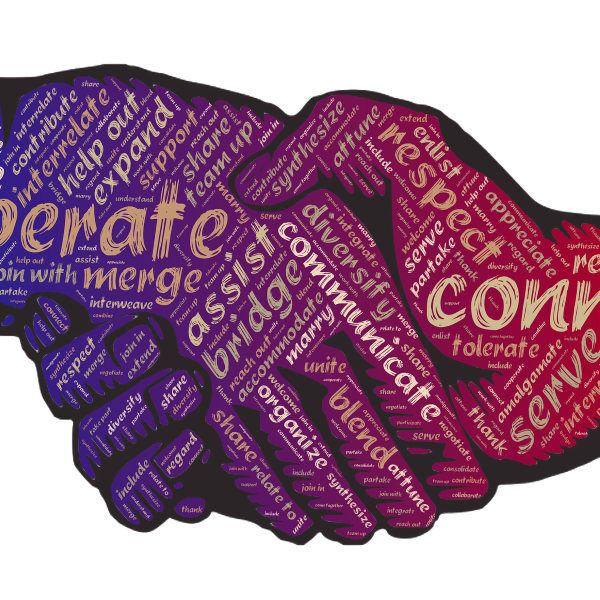Social divides based on many kinds of identities such as race, class, gender, sexual orientation, and religion are often perpetuated within workplaces and organizations. This often occurs through hiring practices and everyday behaviors that reflect accepted social expectations, norms, and roles. Recently, an increase in attention has been given to divides in the workplace based on disability status. In 2021, there were 41.1 million Americans with disabilities. Of that number, 19.1 percent were employed, according to the U.S. Census Bureau and the Bureau of Labor Statistics.
Often, people with disabilities (defined as vision, movement, thinking, remembering, learning, communicating, hearing, mental health, and social relationships), advocate for and seek assistance in finding and keeping a job since they may be viewed as a member of a stigmatized group (ie, devalued, reduced from wholeness because of their disability). In an organizational setting, people from non-stigmatized groups (those without a disability) may include employers and employees who might have difficulty relating to - and with - the person with the disability. This challenge is in part because, until the turn of the twenty-first century, policies have historically promoted a separation between these two groups in the workplace. Both parties, thus, may at times need a mediator to help each other navigate the road to successful employer/employee relationships.
A recently published paper, “Bridgework: A Model of Brokering Relationships Across Social Boundaries in Organizations,” published by Organization Science, explores this very dynamic. Tiffany Johnson, assistant professor at the Georgia Tech Scheller College of Business, Aparna Joshi, professor at the Pennsylvania State University Smeal College of Business, and Glen E. Kreiner, professor at the University of Utah David Eccles School of Business, examine the role of a third-party mediator or “bridgeworker” who acts on behalf of employees with disabilities (in this case, a person with autism spectrum disorder) and the employer to help both parties navigate often unspoken yet profound perceptions that hinder and halt opportunities for people with stigmatized identities to get and maintain employment.
Identifying Social Boundaries
Their research on social identity-based boundaries is unique in that previous analyses focus on organizational boundaries one would normally span across different units and departments. Johnson and her colleagues define social boundaries as “objectified forms of social differences manifested in unequal access to and unequal distribution of resources (material and nonmaterial) and social opportunities.”
In the case of employees with autism and related disabilities, this may include being socially different in the workplace. Examples of this may manifest in not engaging in very common yet unspoken normalized forms of eye contact, personal space, and relating to customers. Given that social boundaries are often so taken for granted, understanding and acknowledging that they exist may be difficult for an interviewer or employer to understand, causing hesitancy or misunderstanding of the person’s “fit”. For example, a person with autism may have difficulty in a position requiring face-to-face interactions with customers but may be fine communicating via email or over the phone. If an employer doesn’t understand this possibility - or is not flexible enough to perceive it- there is a potential for overlooking the employee. This, in turn, often ends up impacting the extent to which people with autism and related disabilities are hired, allocated responsibilities, and/or promoted.
This potential chasm can be negated by bringing in a bridgeworker who understands both sides and can mediate between the two parties.
The “Work” of Bridgework
The researchers identified the actions as bridgework which they defined as a “strategy used by third-party agents, intermediaries, and allies to bridge by shifting value-related perceptions about actors on the other side of social identity-based divides.”
Too often, people from non-stigmatized groups may experience threat, fear, and anxiety about the members of stigmatized groups, while the person with the stigmatized identity may feel their identity is threatened in certain workplaces. This is one of the instances where the bridgeworker can try to forge relationships between the two, and move them towards a place of mutual understanding.
“So often, members of stigmatized or lower status groups are deemed as needing to be changed, molded, or fixed to fit in organizations. One of the most groundbreaking findings of this work is the ways in which the bridgeworkers in our study spent a lot of their time working on members from a non-stigmatized group, or the group that is granted more power and privilege in society, and helping them to create organizations that did not try to “fix” the members of the stigmatized group. Instead, bridgeworkers showed members of non-stigmatized groups how to better fit the people,” said Johnson.
Outcomes in Organizations of Using a Broker
“What characterizes a worker who is valuable (i.e., ‘good’ or' worthy')? Does their belonging to a minoritized or stigmatized group alter perceptions about their value, or their worthiness, to work? Our study suggests that it does and that a particular role in an organization – the bridgeworker (think, allies, advocates, etc.) – engages in a range of psychological and behavioral strategies to try to shift those perceptions to build and sustain relationships across differences,” Johnson explained.
Overall, the researchers acknowledge allyship behaviors aimed at eradicating bias and discrimination in the workplace. One of the implications of their research is that bridgeworkers don’t need to be outsiders of the organization like the job coaches in their study. Leaders who identify the need for a bridgeworker can choose an individual within their organization who aspires to be an ally and who advocates for building a more equitable and inclusive workplace. With training, these allies and advocates within the organization help establish a culture of compassion, flexibility, and creativity.
There is much work to be done in this area, but the researchers have broken new ground into how people in non-stigmatized groups - often those with the power to hire - begin to understand their misperceptions and false beliefs about the value of people within stigmatized groups. It also shows how the bridgeworker helps them to: (a) understand their misperceptions and (b) begin to value not only the work but the whole person. While Johnson and colleagues in no way want to minimize the advocacy done by members of stigmatized groups, themselves (i.e., people with disabilities), the number of workers with disabilities being hired and retained may also increase because of the efforts of brideworkers working alongside them. The research points to positive possibilities.
Read the full article “Bridgework: A Model of Brokering Relationships Across Social Boundaries in Organizations” in Organization Science, September 22, 2022.

